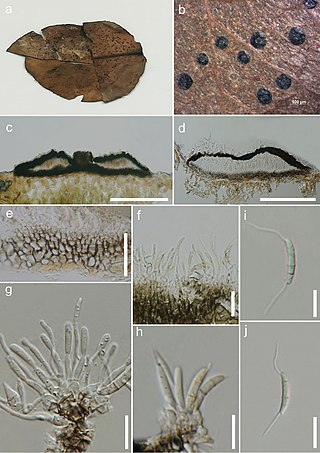Related Research Articles

Eucalypt is any woody plant with capsule fruiting bodies belonging to one of seven closely related genera found across Australia: Eucalyptus, Corymbia, Angophora, Stockwellia, Allosyncarpia, Eucalyptopsis and Arillastrum. In Australia they are commonly known as gum trees.

The Nectriaceae comprise a family of fungi in the order Hypocreales. It was circumscribed by brothers Charles and Louis René Tulasne in 1865. In 2020, an Outline of fungi was produced and listed 70 genera and about 1,336 species.
The fungal genus Truncatella in the family Sporocadaceae, and in the Amphisphaeriales order, includes plant pathogens such as Truncatella laurocerasi.

The Mycosphaerellaceae are a family of sac fungi. They affect many common plants, such as eucalyptus, the myrtle family, and the Proteaceae. They have a widespread distribution.

The Phacidiaceae are a family of fungi in the order Helotiales. According to a 2008 estimate, the family contained seven genera and 148 species.
Teratosphaeria is a genus of fungi in the family Teratosphaeriaceae; according to the 2007 Outline of Ascomycota, it was placed in the Phaeosphaeriaceae, but the placement within this family was uncertain. It was confirmed in 2020, within Teratosphaeriaceae by Wijayawardene et al. 2020.
Camarosporula is a genus of fungi in the class Dothideomycetes. This is a monotypic genus, consisting of the single species Camarosporula persooniae. It has the Teleomorph synonym of Anthracostroma persooniae.

Seiridium is a genus of plant pathogens in the family Sporocadaceae.

Monochaetia is a genus of fungi in the family Sporocadaceae. Species in the genus are typically plant parasites and saprobes, and cause leaf spot diseases on various hosts.

Teratosphaeriaceae is a family of fungi in the order Mycosphaerellales.
Seimatosporium is a fungus genus within the family Sporocadaceae.

The Stachybotryaceae are a family of fungi in the order Hypocreales; the genera it contains have been described as "hyper-diverse".

The Amphisphaeriales are an order of fungi within the class Sordariomycetes and subclass Xylariomycetidae.

The Sporocadaceae are a family of fungi, that was formerly in the order Xylariales. It was placed in the Amphisphaeriales order in 2020.

Sporocadus is a genus of plant pathogens in the family Sporocadaceae.

Discosia is a genus of plant pathogens in the family Sporocadaceae.
Heterotruncatella is a genus of plant pathogens in the family Sporocadaceae.
Sarcostroma is a genus of fungi in the family Sporocadaceae. Most species of this genus are saprobes, endophytes or pathogens on leaves.
Bartalinia robillardoides is a species of fungi within the genus Bartalinia and the Sporocadaceae family. Distinguished by their unitunicate asci, containing 3-4 septate, Bartalinia robillardoides species have been found in water samples and growing on medium like flowering shrubs and trees. Collections of this species have been collected in Australia and New Zealand, Europe, South America and Asia. It has been identified to be both endophytic and pathogenic. This species can cause leaf spots that raise concerns to economically valuable plants.
Falcocladium is a genus of fungi, within the monotypic family FalcocladiaceaeSomrith., E.B.G. Jones & K.L. Pang, and within the monotypic order FalcocladialesR.H. Perera, Maharachch., Somrith., Suetrong & K.D. Hyde, within the class Dothideomycetes. They are saprobic on leaf litter, including the leaves of Eucalyptus grandis and Eucalyptus camaldulensis in tropical and terrestrial habitats.
References
- 1 2 3 "Allelochaeta Petr. 1955 - Biota of NZ". biotanz.landcareresearch.co.nz. Retrieved 20 February 2023.
- 1 2 3 4 5 Crous, P. W.; Liu, F.; Cai, L.; Barber, P. A.; Thangavel, R.; Summerell, B. A.; Wingfield, M. J.; Edwards, J.; Carnegie, A. J.; Groenewald, J. Z. (December 2018). "Allelochaeta ( Sporocadaceae): pigmentation lost and gained". Fungal Syst Evol. 2: 273–309. doi:10.3114/fuse.2018.02.08. PMC 7225576 . PMID 32467891.
- ↑ Wijayawardene, Nalin; Hyde, Kevin; Al-Ani, Laith Khalil Tawfeeq; Somayeh, Dolatabadi; Stadler, Marc; Haelewaters, Danny; et al. (2020). "Outline of Fungi and fungus-like taxa". Mycosphere. 11: 1060–1456. doi: 10.5943/mycosphere/11/1/8 .
- ↑ Chethana, Thilini (14 November 2022). "Allelochaeta - Facesoffungi number: FoF 13569". Faces Of Fungi. Retrieved 18 February 2023.
- ↑ Geoffrey Clough Ainsworth Ainsworth & Bisby's Dictionary of the Fungi (2008) , p. 20, at Google Books
- ↑ Raj, T. R. Nag (March 1978). "Genera coelomycetum. XIV. Allelochaeta, Basilocula, Ceuthosira, Microgloeum, Neobarclaya, Polynema, Pycnidiochaeta, and Xenodomus". Canadian Journal of Botany. 56 (6): 686–707. doi:10.1139/b78-076.
- 1 2 Crous, P. W.; Wingfield, M. J.; Cheewangkoon, R.; Carnegie, A. J.; Burgess, T. I.; Summerell, B. A.; Edwards, J.; Taylor, P. W. J.; Groenewald, J. Z. (August 2019). "Foliar pathogens of eucalypts". Stud Mycol. 8 (94): 125–298. doi:10.1016/j.simyco.2019.08.001. PMC 6797021 . PMID 31636729. S2CID 202013426.
- 1 2 "Allelochaeta – Plant Parasites of Europe". bladmineerders.nl. Retrieved 18 February 2023.
- 1 2 "Sporocadaceae Corda Allelochaeta Petr. Allelochaeta parafalcata Crous". florabase.dpaw.wa.gov.au. Biodiversity and Conservation Science Western Australian Herbarium. Retrieved 19 February 2023.
- ↑ "Allelochaeta Petr., 1955". www.gbif.org. Retrieved 18 February 2023.
- ↑ "Allelochaeta - Search Page". www.speciesfungorum.org. Species Fungorum. Retrieved 18 February 2023.
- ↑ "Allelochaeta falcata". pubchem.ncbi.nlm.nih.gov. Retrieved 19 February 2023.